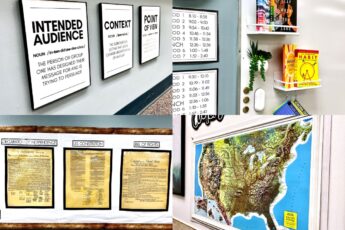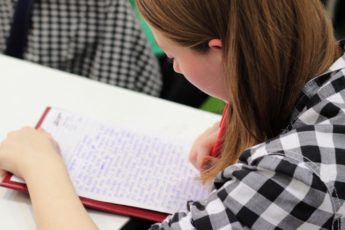Poetry is a great way to explore the sentiments and issues of a particular era, but as a history teacher it can be hard to know where to start! Not only can poems be intimidating to students and teachers alike, but studying a poem as a piece of history is different than studying it as a piece of literature.
That’s why the analysis strategy used by the English teacher down the hall doesn’t quite work for your learning objectives in U.S. History! Metaphors are fantastic elements of written expression, but your focus is different. Instead, you need students to analyze a poem as a historical primary source, one that adds richness by using artistic, emotional, and creative elements, and acting as a great contrast to the presidential speech they’ll be examining the following day.
It took several tries to perfect the strategy I use to incorporate poems into my units, as well as settle on the best ones to use, and now that I have found a formula that works I want to share both with you!
Here are my best tips for how you can effectively teach poetry in your middle or high school U.S. History classroom, and a list of poems that are perfect to use!
Plus, scroll down to the bottom to download a FREE print-and-go analysis lesson of my most favorite one—Emma Lazarus’s famous work, “The New Colossus.” Or, click the button below to go straight this lesson download!

But before you dive into the DECODE process, you need to set yourself up for poetry success:
1. Pick the right poems
Not all the greats of American poetry qualify. Poems that have clear connections to larger historical issues are the ones you want.
They need to be relatively short and straightforward, so that your classroom dialogue can immediately focus on the author’s historical references and perspectives, and not get sidetracked by comprehension challenges.
Also, be open to works that don’t fit the standard definition of a poem. Try out some poem-like creative essays or song lyrics.
Scroll down to check out the list of 11 works fitting this description that I’ve curated for you!
2. Leave lots of white space.
This is why a brief poem or just a few stanzas works so well. Poetry can already be intimidating for a lot of students, so a whole bunch of it crammed on a page isn’t going to help the situation. When printing your poem handouts, be sure to leave plenty of room for note taking and analysis.
3. Arm them with both highlighters and pencils.
Decide what is the most important thing (or two) you want students to be looking for as the poem relates to the historical topic. Maybe it’s the author’s real life personal experience; maybe it’s a comparison he or she is trying to make. Have students color-code for that so it doesn’t get lost among the rest of the annotations they make on their paper.
4. Identify the academic words ahead of time.
Pre-bold them on your handout. Define them as a class before the first read. Have your students verbally repeat any ones that are tricky to pronounce so that whoever is reading that line aloud (always, always read poems aloud!) will be equipped to do so successfully.
5. Give lots of context.
Introduce the author, his or her background, and point of view. Make it no surprise the angle he or she is going to take with the topic they are referencing before the poem is read. Poetry for historical sake shouldn’t be a guessing game of what the poet is discussing, but rather a dive into their perspectives, insights, or influences on the topic.
Now this doesn’t mean you’ve done all the thinking for your students. My favorite way to preface any primary source is with a leading question that follows this general formula: “Based on what you now know about this author, how do you think she/she felt?”or “Looking at the title he/she chose and thinking about their background, what do you think his/her perspective on this issue is?”
This allows your students to infer the poem’s punch line instead of you giving it away. Then, they are empowered when their educated guess is proven right!
Now you’re ready to use the DECODE strategy!

This has become my go-to for everything poetry in my history classroom. I love that the acronym references “cracking the code” of poetry to even further help demystify this rich type of primary source! Here’s how it works:
Read the poem aloud either entirely yourself or at least the first stanza or two before handing it off to the students to read aloud.
Define: Even after you have defined certain words prior to the first reading, give students the time to identify any other words they individually need to clarify.
Read the poem a second time, either aloud by a new student, or have them read it silently, depending on its length, looking specifically for emotion.
Emotion: Help students label the emotion of specific stanzas or of the whole poem. More often than not, the emotion in a poem shifts, so really look at each stanza individually.
Read the poem a third time, now looking for any changes or comparisons happening. This requires looking at the poem now as a whole work. Every single poem has some sort of change and continuity or makes a comparison or contrast. That’s what makes poetry powerful. Usually a poem has a few.
Change / Continuity / Contrast / Compare: Examine the stanzas now in how they fit into the poem as a whole to create its larger, thoughtful message.
Outside Information: When previewing the author’s backstory and the larger historical issue, before reading the poem with students, simmer it all down into three key pieces of information for them to reference back to when analyzing. That way students can now reference back and make those connections.
Read the poem a fourth time, likely now as a quick skim, looking for distinct or powerful words.
Denotation / Connotation: Help students identify specific words or phrases that the author intentionally chose over others for the meaning they created. Whether it was because they created a crystal clear image or because they hold an extra or double meaning, the author chose each one on purpose. Encourage your students to make conclusions as to why he/she chose the words they did.
Encapsulate: Culminate the poem’s meaning and impact on the historical era into a single sentence. It helps to give your students a sentence stem to get them going. For example, “After President Lincoln was shockingly assassinated, Walt Whitman processed his and the nation’s grief by…”

Here are the poems that have made it onto my go-to list. Don’t feel like you need to use all of them! I certainly don’t in any given school year. If you are brand new to using poetry or want to see this strategy in action, I encourage you to sign up for access to my digital library of free resources, which includes a complete lesson that DECODEs Emma Lazarus’s “The New Colossus.”
11 Poems Perfect for Your U.S. History Students
“Paul Revere’s Ride” by Henry Wadsworth Longfellow
“I Hear America Singing” by Walt Whitman
“O Captain! My Captain!” by Walt Whitman
“The New Colossus” by Emma Lazarus
“This Land Is Your Land” by Woody Guthrie
“I, Too” by Langston Hughes (which is his direct response to Whitman’s “I Hear America Singing”)
“Will V-Day Be Me-Day Too?” by Langston Hughes
“Theme for English B” by Langston Hughes
“Still I Rise” by Maya Angelou
I hope these ideas and tips help you bring poetry into your U.S. History class!
Click below for FREE download!
Click below to get a complete print-and-go lesson plan that DECODE’s EmmaLazarus’s “The New Colossus.”
Feature image photo credit: Nick Hillier






